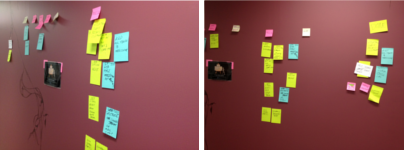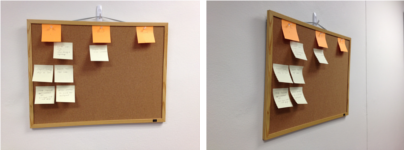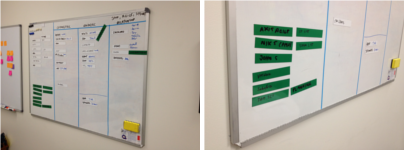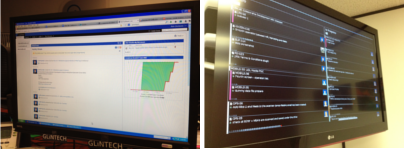If you’re aiming to be agile, at some point you’ll probably end up using some kind of a wallboard. What’s a wallboard? The most simple way to describe it is probably as a visual way of displaying how tasks are progressing: To do, In Progress, Done. They’re more common amongst software development teams, but really any team can use them.
The idea’s about visibility, so that anyone can take a quick glance and get an idea of where things are at. Think of it a bit like turning up to a sporting match halfway through, looking at the scoreboard and getting a snapshot of what’s happening.
There are heaps of different kinds of wallboards out there, from super simple bits of paper to some very complex (and very cool) digital technology. That got us thinking about some of the wallboards we’ve used at GLiNTECH recently...
Post Its

Everyone’s that’s been involved in an agile project will no doubt be familiar with the bright little squares of sticky paper that form a Post It wallboard. Some say it’s primitive. Others say it’s simple, cheap and effective. And try as they might, no one can seem to fully get rid of the Post It wallboard. It’s a classic way to be agile (and a guilty pleasure in this digital age).
Cork Board

About as old school as it gets before you’re back to using chalk on a blackboard. Cork boards come with down sides; dropped pins, putting holes in the wall if you go beyond the borders of the board, the uninspiring brown corky colour. However, there’s a reason it’s used: it’s simple and it works.
Magnets

Combined with a whiteboard marker, this awesome agile tool offers more than your average board. With the ability to write directly on it and hold things down, a magnetic whiteboard wallboard is kind of like Post Its v2.0. Bonus points for the satisfying ‘clack’ as you magnetise another task to the project.
Pegs

Always looked back on with fondness in the GLiNTECH office, this washing line-inspired board is where we used to hang all our dirty tasks. We entered it in Atlassian’s ‘Best Old School Wallboard’ competition a while back - and we won a TV! Which kind of led to the peg board’s demise as we were inspired to go fully digital...
JIRA/GreenHopper

On-screen is how agile is done in the digital age: real-time data, drag & drop, automatic updates, collaboration from anywhere - wallboards sure have come a long way. There are a lot of digital wallboards out there, but JIRA with GreenHopper is the one we use, partly because it integrates with Confluence but mainly because it’s pretty simple to use, pretty comprehensive and pretty awesome.
We took ours a step further and connected our JIRA dashboard to televisions mounted on the walls. Now we have agile in HD, with our tasks broadcast through the office to give more visibility. JIRA TV is a popular channel in these parts.
The Future...

Above images taken from Atlassian’s Ultimate Wallboard Competition
Wallboards keep evolving and there’s some really cool stuff in the pipeline incorporating new technology. For example, people started looking at ways to interact with multiple technologies like projections or integrating JIRA with an Xbox using Kinect. The idea is to project your agile board onto a wall then manipulate it using motion sensors - just wave your hand and the tasks move around on screen. Pretty cool stuff and it suggests the world of wallboards is set to get a whole lot more interesting.
If you want help setting up a wallboard using Post Its, Cork boards, Magnets or Pegs, you probably don’t need any - just give it a go! If you want to try JIRA, Scrum with JIRA Agile.
